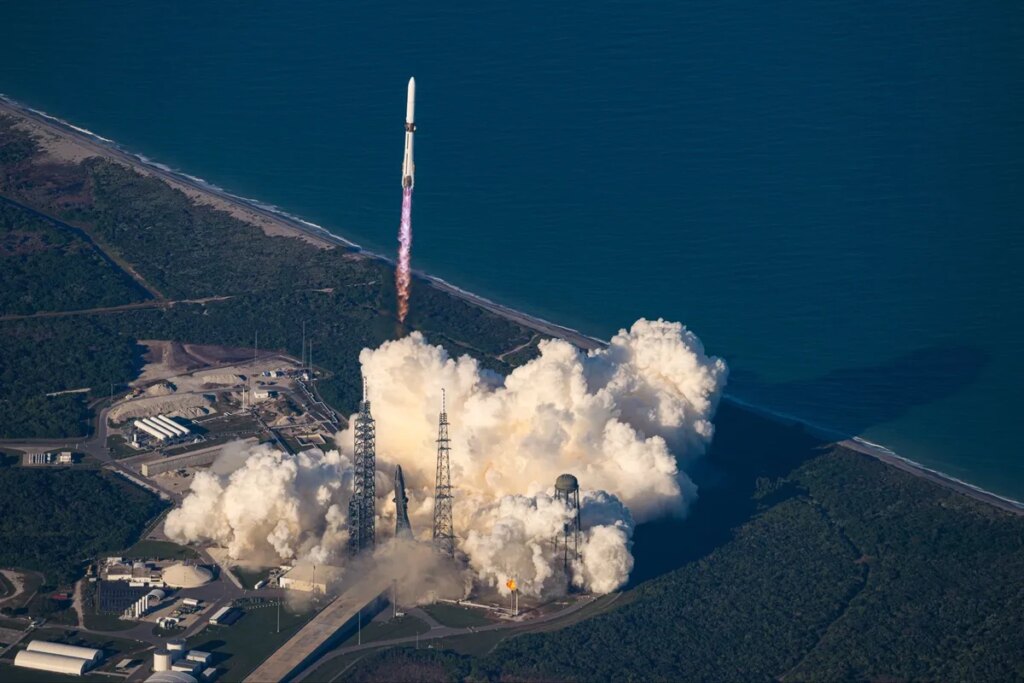November 13, 2025
4 min read
This Mars-Bound Spacecraft Will Test Jared Isaacman’s Vision for NASA
NASA’s presumptive next leader wants to outsource more of the space agency’s interplanetary science. The newly launched ESCAPADE mission to Mars offers a sanity check for those plans
NASA’s ESCAPADE (Escape and Plasma Acceleration and Dynamics Explorers) mission launched at 3:55 p.m. EST atop a Blue Origin New Glenn rocket at Launch Complex 36 at Cape Canaveral Space Force Station in Florida.
Blue Origin’s New Glenn rocket just launched a small trial of the kind of space agency envisioned by Jared Isaacman, the tech billionaire and private astronaut whom President Donald Trump has renominated to lead NASA.
On Thursday afternoon the twin orbiters of the Escape and Plasma Acceleration and Dynamics Explorers (ESCAPADE) mission drifted out of New Glenn’s fairing and into space—on their way to map Mars’s interactions with the “solar wind” of charged particles flowing from the sun.
The science is almost a secondary priority, though. Built mostly by the aerospace firm Rocket Lab, launched by Blue Origin and led by the Space Sciences Laboratory at the University of California, Berkeley, ESCAPADE is also a test to see if a mishmash of academic and commercial teams can send a twin-orbiter mission to Mars for under $100 million. It debuts as Isaacman makes his case for a NASA with more low-cost, outsourced science missions.
On supporting science journalism
If you’re enjoying this article, consider supporting our award-winning journalism by subscribing. By purchasing a subscription you are helping to ensure the future of impactful stories about the discoveries and ideas shaping our world today.
As the final installment in NASA’s largely unsuccessful Small Innovative Missions for Planetary Exploration (SIMPLEx) program, however, ESCAPADE’s risk of failure is high. Its first few weeks in space, as controllers activate and test the twin spacecraft, will be especially nail-biting.
“I wouldn’t want to say it’s a make-or-break moment” for NASA’s push to cut costs, says Jack Kiraly, director of government relations at the Planetary Society. “It’s just another data point on whether or not this is a viable path to do high-level, important science.”
A Trial-and-Error Plan for Planetary Science
After launching ESCAPADE into orbit, New Glenn’s booster stuck its first-ever landing, touching down on a barge in the Atlantic Ocean and bringing Blue Origin a step closer to the reusability that has catapulted SpaceX into global launch dominance.
Meanwhile, in Long Beach, Calif., Rocket Lab mission controllers waited tensely for the first ping of data from ESCAPADE’s orbiters.
The last SIMPLEx mission, called Lunar Trailblazer, spun out and lost contact shortly after its liftoff in February. Two prior missions also failed soon after launch. One never even made it to launch and was indefinitely shelved.
In a similar program—Commercial Lunar Payload Services (CLPS), which called for companies to pitch and run their own moon-landing missions—only one of five so far has fully succeeded.
Despite this dismal track record, Isaacman wants more.
The tech billionaire did not respond to a request for comment from Scientific American. But earlier this month he clarified his intentions for NASA after the leak of his controversial “Project Athena” plan for overhauling the agency.
In a long post on X clarifying the plan’s provisional nature, Isaacman confirmed that he wants to “expand the CLPS-style approach across planetary science.” He added that it’s “better to have 10 x $100 million missions and a few fail than a single overdue and costly $1B+ mission”—a dig at NASA’s traditional approach to space science.
But Kiraly sees this as “a misunderstanding of what science is,” adding that “10 $100-million projects don’t necessarily equal $1 billion.” Compared with NASA’s multibillion-dollar Mars rovers and space telescopes that have made major scientific breakthroughs, the combined efforts of CLPS and SIMPLEx have delivered scarcely any science returns at all.
That doesn’t necessarily mean such programs aren’t worth it. NASA has been betting for years that companies can eventually run major missions for cheaper, and Isaacman apparently intends to double down on that wager.
“I want to see more planetary science, and if the way to do that right is through these new contracting methods and new providers, then great,” Kiraly says.
ESCAPADE’s Next Steps
Isaacman’s approach would be good news for Rocket Lab, which is set up to run future missions end-to-end—building, launching and operating in-house.
“Rocket Lab is ideally positioned to bring more interplanetary missions within reach,” says Rocket Lab spokesperson Morgan Connaughton. “By reducing reliance on third-party suppliers, we can drive down costs and streamline production to deliver hardware faster.”
Rocket Lab will power up the two ESCAPADE spacecraft over the next few weeks, as the two probes cruise toward Lagrange point 2, or L2. This is a region of gravitational quiescence about a million miles from Earth, where ESCAPADE will linger for a year awaiting a more favorable alignment between Earth and Mars.
After ESCAPADE settles into its temporary stay at L2, the mission controllers and scientists of the Space Sciences Laboratory at U.C. Berkeley will take over. For a few weeks, in sporadic windows of communication through NASA’s Deep Space Network, they’ll turn on ESCAPADE’s four instruments to ensure each is ready for prime time.
“If you can demonstrate that you can go to Mars with two spacecraft for around $100 million, that greatly bolsters the case for more commercial efforts, more university efforts,” Abhi Tripathi told Scientific American in September. “That message, I think, resonates with many in the current leadership.”
ESCAPADE won’t be the end of low-cost, outsourced planetary science at NASA. Four CLPS missions are slated to launch next year. If they go well, they’ll turn around that program’s success rate.
It will be a year before the two ESCAPADE spacecraft fire their engines to begin the nine-month journey to Mars. By then, the question of who runs NASA will hopefully be settled.

